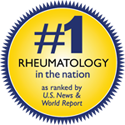OA is diagnosed by a triad of typical symptoms, physical findings and radiographic changes. The American College of Rheumatology has set forth classification criteria to aid in the identification of patients with symptomatic OA that include, but do not rely solely on, radiographic findings.
- SYMPTOMS: Patients with early disease experience localized joint pain that worsens with activity and is relieved by rest, while those with severe disease may have pain at rest. Weight bearing joints may “lock” or “give way” due to internal derangement that is a consequence of advanced disease. Stiffness in the morning or following inactivity (“gel phenomenon”) rarely exceeds 30 minutes. Patients have pain which is generally worse at the end of the day compared to the beginning (because symptoms become worse with use / activity).
- SIGNS / EXAM FINDINGS: Physical findings in osteoarthritic joints include bony enlargement, crepitus, cool effusions, and decreased range of motion. Tenderness on palpation at the joint line and pain on passive motion are also common, although not unique to OA. Notably absent in OA is the boggy synovitis seen in inflammatory arthritis (such as rheumatoid arthritis) or the intense, hot inflammation of crystalline arthropathies. The distribution of joint involvement in OA is important as well. Knees and hips are common sites (because they are weight-bearing joints). Hands can be involved, particularly the distal and proximal interphalangeal joints where bony enlargements can become quite dramatic and are referred to as Heberden’s and Bouchard’s nodes. The base of the thumb (first carpometacarpal joint) is frequently involved in OA and can even become swollen and may be mistaken for wrist involvement.
- XRAY / IMAGING FINDINGS: Radiographic findings in OA include osteophyte formation, joint space narrowing, subchondral sclerosis and cysts. The presence of an osteophyte is the most specific radiographic marker for OA although it is indicative of relatively advanced disease. Peri-articular osteoporosis and erosions should not be demonstrated in OA and the presence of such should prompt investigation for an alternative diagnosis. Although conventional x-rays are the most inexpensive and readily accessible method of imaging to confirm a diagnosis of OA, magnetic resonance imaging (MRI) is becoming an increasingly important diagnostic tool. Compared to conventional x-rays which only can show bony changes, MRI has the benefit of providing information about cartilage, periarticular structures (tendons), and can show ‘edema’ in the subchondral bone. MRI is being investigated as a tool to assess the progression of OA (natural history) as researchers continue to try and develop therapies to treat OA.

